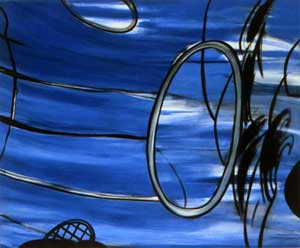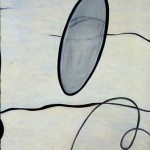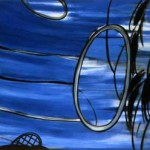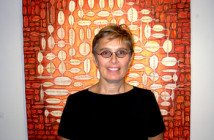Looking through stacks of paintings leaning against the walls of the Brooklyn studio of John L. Moore there were several persistent forms drawn in black, painterly outline against solid red, blue or white grounds. The icons included ovals, what read as trees and bare branches, and vertical strokes that he identified as the element of fire. On the table was a thick stack of very large sheets of drawing paper with similar markings in gestural black on a white ground.
He is of my generation, actually a couple of years older and now retired from teaching at Skidmore College. I recall what we were taught back when by professors rooted in abstract expressionism to “Draw from the shoulder, using your whole arm, not just your hands and fingers.” He is of that manner and one can feel the heat and energy, the sweeping movement as the mark is applied to the support like screeching rubber from the tires of a drag racer.
Looking more closely at the surface of some of the drawings, particularly at the top of the pile, implying that they are more recent in work of the past couple of years, were some smudged elements. Drawn and then deliberately rubbed out or partly obscured. This is the aspect of the work that he tantalized me about stating that it was “unshowable” when he discussed it rather obliquely over dinner after an opening at the List Visual Arts Center where his wife, Jane Farver, is director. When I asked about his work he referred me to the website which led to this Sunday morning studio visit.
While barely recognizable the partly obliterated aspects were sexually explicit. Why draw them and then remove them? It was a mystery that he did not explain. This proved to be a pattern in the dialogue. Subjects brought up but then not fully explored, or retraced, and backtracked. Having made a provocative statement that I took down in my notebook, on several occasions, he asked not to be quoted. That it was either too obvious or private. It all became rather surreal. This reminded me of when Rauschenberg asked deKooning for a drawing which he rather carefully erased. What follows arguably is in that spirit. A studio visit and dialogue conducted, recorded, but partly erased.
The primary challenge and issue was to understand the work as well as the artist. Just how did the paintings and drawings come to be and what do they mean? Of course, this is where artists wiggle and squirm. To be pinned down about what something means. He did reveal that the ovals were mirrors, but that they are empty, devoid of images or reflections. They represent an enigma or conundrum. The branches are signifiers, filtered and codified through decades of life experience and reflection on race. Later he showed me earlier work, from the pages of a catalogue, when the paintings, with collaged elements, were more didactic. There the lynching imagery was explicit. These issues have become ever more refined and internalized now as signs, symbols and signifiers. There was also fire and rain. The work is simplified, abstracted and elemental. When I pushed further there was a continuing response that it is “complicated.” Words and images are erased or smudged because there are no simple answers.
But I can be a relentless inquisitor. As one artist I have been working with for the past year responds “You can keep asking the same questions whoever many times and in as many different ways that you want but I am just not going to explain my work.” Ok but artists get annoyed when our interpretations, often out of frustration, do not prove to be accurate or satisfying. The good part, however, is that it provokes them to correct mistakes which inches us closer to the truth.
When all else fails stick to facts and get the history. Biography is an illusion that you are getting somewhere while the greater issues lurk and loom in the dark.
John L. Moore, so identified to not be confused with another New York artist, the realist John Moore, was born in Cleveland on February 2, 1939. The Cleveland Museum became important to his development. His mother was a government worker who divorced his father when he was six. John grew up in a working class family and started at GM in 1964 at the time married with two kids.
For three years, from 1958 through 1961, he was a paratrooper. All told he completed about 22 drops on an average of once a month. He was a part of an elite strike force and “trained to kill.” The military proved to be a vital part of his persona and left him with a great sense of accomplishment. After that training and discipline anything was possible. “You do stuff you never though you would do,” he recalled. There was the challenge to get “resocialized” after the military.
While working at GM he earned an undergraduate degree at Kent State in 1972 and a graduate degree in 1974 and was just nine credits short of an MFA. During a lecture at the Cleveland Museum he asked a question. After the lecture “She asked me if I would like to help teach a class instructing teenagers in painting and drawing. I had been teaching at a community college. I was assisting in the class for a few weeks when she quit and I inherited the class. All this time I was still working for GM. A year later the Detroit Institute of Art was recruiting and I went for an interview. I had never had a job interview prior to that. Back home I got a call from the Cleveland Museum to come in for an interview for a position in the department of education. The woman who hired me to assist her teaching told me that she wanted to integrate the museum. I did tours, gallery talks and taught the teenage and adult studio classes. Several years later I became the assistant curator in the department of art history and education. It was a museum within the museum with its own collection and we did shows and produced catalogues. I did a couple of exhibitions and a Black Film Series before leaving the museum. I was well read and after being airborne anything was possible.”
At the time he was one of the few African Americans employed by a major American museum. By 1985 they moved to New York when Jane took a position at the Alternative Museum. “In 1983 I had a show at the Alternative Museum. This made showing in New York seem easy.” He has shown in New York with Howard Scott and Tomoko Liguori which started as the Grand Street Gallery. His last New York show was in 2002.
I tried to get back to questions about the work. “I’m a hybrid,” he responded. “It’s always about real things but I abstract them into mirrors, trees and branches. My early work in the 1970s was figurative. What freed me up is that I am now more conceptual about ideas. They are rooted in politics and history. I have been told that my work isn’t ‘black enough’ for most museums. My work is all about the middle passage but the mirror is empty you can’t see yourself. My work asks questions where other artists perhaps tell you stories. Maybe this is tougher. Because you can’t see it.
“I did a lynching in 1986. It was the most famous lynching in America. In Marion, Indiana in the 1930s. In the crowd were two young girls. This was a party. They were smiling and looking at the camera. I wondered what happened to them. Did they become mothers and perhaps teachers? So from that the dead branch became abstracted and stripped down. The best intelligence in art is abstraction. It is not formulaic. Telling stories in art has a beginning, middle and end. But is that just a lot of complex stuff? My paintings are crude because I am a rough around the edges kind of guy. They reflect me because I do them.”
The concept of abstraction started when he was airborne. Prior to the military he had never been in an airplane. From the sky he became fascinated by the patterns of the landscape. Its abstraction that rapidly became a reality as one floated closer to the earth and a landing carrying a full load of equipment. “The closer you get the faster it comes,” he recalled. “And you are trying not to break an ankle. But that landscape became a part of the paintings.”
In addition to exhibiting his work John has also curated a number of exhibitions but wasn’t anxious to go into detail. Part of that it trying to convey his primary identity as an exhibiting artist. He displayed an impressive stack of catalogues to back that up and pointed out coverage in the New York Times on more than a dozen occasions. About his current Mirror series he states quite simply that “I think they are as important as anyone else’s work out there right now.” Yes, I would agree with that. And while it takes some probing to understand them, this is not always the case with viewers. He relates how during exhibitions individuals have approached him conveying that they intuitively understand and are moved by the imagery. As always it is a matter of context. But I truly appreciate viewing mature work that makes me dig deeply rather than just get in my face. Perhaps this is what he means stating that the work is not “black enough” compared to the work of successful younger black artists.
Arguably the success of many young black artists is frequently based on conveying provocative racial content to a primarily white liberal audience. What I feel and appreciate about John’s work is that it is profound, mature and mediated. It is reflective of life experience and has evolved from earlier more polemical work.
But he did share an anecdote of how he curated a major exhibition while still an employee at GM. “Out of some 4000 employees at GM there were 400 artists. We did a juried show of about 100 artists and for the show, which lasted just three days, GM provided an enormous garage which we transformed. They gave us carpenters and painters to make it suitable and we had an enormous opening. It was a great event and terrific PR for GM.”
You get the feeling that there is no limit to his energy and imagination. He gets the job done but doesn’t like to brag about it.
- John L. Moore, Mirror, Red, Oil on Canvas, 2000.
- John L. Moore, Black, White, Blue, Oil on Canvas, 2000.
- John L.Moore, Black & Blue, Oil on Canvas, 2001.
Links:
JohnLMoore.net
All images are courtesy of the artist.







